What is Sankalp (Sankalpa) Vidhi information, mantra, significance, importance, facts | How to take Sankalp before puja | What is sankalpa in pooja?
Namaste friends, how are you doing today? Welcome to #BhagavanBhakthi website / blog.
Bhagavan Lord Sri Vishnu (Krishna) (Rama) (Hari) (Narayana) (Trivikrama) (Narasimha) (Vedavyasa) and Goddess Lakshmi (Rukmini) (Sita) (Dharini) blessings to you and your family!
In this website / blog, you will always learn about #Hinduism #Sanskrit language.
Also subscribe to my YouTube channel from this link #BhagavanBhakthi to view videos about #Hinduism #Sanskrit language.
Just before going to “What is Sankalp (Sankalpa) Vidhi information, mantra, significance, importance, facts | How to take Sankalp before puja | What is Sankalpa in pooja?“, let us have some brief information.

Sankalp in Sanskrit is pronounced and written as संकल्प / संकल्पं / संकल्पम् / saṅkalpa / saṅkalpaṁ.
In the Hindu Sanatana Dharma sampradaya / tradition before performing any divine or good work we should undertake something known as ‘sankalpa’. Sankalp is a kind of type of resolution that we do ourselves and to the antaryaami Bhagavan / God who is within us.
The Hindu Sanatana Dharma Vedas says that the multiverses (unlimted Universes) has evolved through a ‘Sankalpam’ of Bhagavan Sri Vishnu. Etymologically, ‘Sankalpam’ is a Samskruta / Sanskrit word.
The Vedic meaning of the word ‘Sankalpa’ means, someone doing a resolution, wish, desire, determination, aiming at, a free will.
In English the word Sankalpa has few meanings like having good intention or taking an oath or doing a resolution to complete the wish of some personal work (of oneself of family or relative or friends or someone who is very close and beloved to us).
Also, in English the word Sankalp (Sankalpa / Sankalpam) can be explained with few words like a solemn pledge, making a promise, taking a vow, to make some commitment, to take an oath, to do something good for yourself and/or to your family or relatives or friends or others etc.

Now let us know the meaning of the word ‘Sankalpa’: In traditional Sanskrit language ‘Sankalpa’ means, ‘San’ = good, auspicious and ‘Kalpa’ means doing a Shaastra (a ritual) as per the Vedic tradition.
Also, in Sanskrit ‘Sankalpa’ means a proposal to do something good in a Vedic or in the way as prescribed in Hindu Vedic Shastras (Texts). In any Dharmic ceremony or ritual, generally we can observe a person making a ‘Sankalpa’ (firm resolution) to achieve the purpose of that ceremony.
Similarly, ‘Sankalpa’ literally means taking firm and right decision to accomplish one particular work in spite of multiple obstacles, troubles to complete that desirous work. ‘Sankalpa’ can’t come all of a sudden.
‘Sankalpa’ is a conception of a deep routed and strong desire formed in the inner heart, that is of the inner mind. This means, a seed that one consciously plant in his / her mind, with a great desire to achieve that work even though he / she may have to face multiple levels of obstacles, troubles etc.
All the Yagnas and worships are accomplished after taking a vow (Sankalpa) for the safe completion of that work. In simple words, a ‘Sankalpa’ is a special expression of feeling which the Saadhaka (doer) has for accomplishment from a Saadhana (task).

Thus by taking a vow, or pledging he / she will be committed in accomplishing his / her goal. Taking a vow (Sankalpa) means he / she will be committed to accomplish some type of work (especially the divine work).
This is similar to a person like an elected political leader, or a Government officer taking a vow and / or a pledge of secrecy in the name of God before taking charge of his / her office. Another good example is that, just before the start of the elections, political parties release their manifesto.
This is nothing but their Sankalpa. One more example is that, in courts before commencement of a trial the witnesses are asked to take vow and a pledge in the name of God (usually in India, this is done using the Great Bhagavad Gita).
In Hindu Sanatana Dharma, when a person speaks something after taking a vow, then that has to be accomplished in time without causing troubles to others. Also another example is that, at the time of induction an employee, he / she is asked to sign an oath of secrecy.
This is nothing but a Sankalpa of an employee. All these are nothing but Sankalpa in different forms for different causes. But it should also be noted that, just a simple ‘Sankalpa’ alone is not enough to accomplish a work.
Beside doing Sankalpa, he / she should have strong dedication, determination, will power, discipline, resolution, strength of will, strength of character, single mindedness, sense of purpose, firmness in purpose accompanied by sincere hard work, persuasion to accomplish that work within a predetermined time.

A Sankalpa acts as a basic foundation in accomplishing the task or reaching the goal with hard determination with great bhakti / devotion if Bhagavan. When bhakti / devotion gets added to the Sankalpa, it gains strength and gets proper direction with the blessings of Bhagavan Sri Vishnu.
We have several Vedic and Puranic historical examples of the power of Sankalpa. One of the greatest example is of the achievements of Lord Hanuman. Few other examples are like:
Bhakta Prahlada (to free this world from the clutches of Hiranyakashipu), Bhakta Dhruva (he wanted to become a King), Bhakta Markandeya (he wanted to get to full lifespan),
Bhagiratha (he wanted to bring Ganga to earth so that all his ancestors would be moksha / liberation), Sati Savitri (she wanted her husband the full life span) etc.
Even today’s example is of our dear Prime Minister Sri Narendra Modi to make our nation ‘aatma nirbhar’ (Complete self dependent). This is also a great example of a Sankalpa in the modern day.

Mantra (Sloka) of Sankalpa in Sanskrit (Hindi), Kannada, English is as given below (for both India and USA) (with its Significance) : Usually the Sankalpa has to be performed in a sitting position called ‘Padmasana’ by clasping the right palm over the left. The hands should be rested on the right thighs near the knee. It starts like this…
For India : श्री गोविन्द गोविन्द ! शुभे शोभने मुहूर्ते आद्य ब्राह्मणः द्वितीय परार्धे श्वेत वराह कल्पे वैवस्वत मन्वन्तरे कलियुगे प्रथम पादे जंबो द्विपे भरतवर्षे भरतखण्डे गोदावर्याः दक्षिणे तीरे शालेवाहनशखे बौद्धावतारे रामक्षेत्रे अस्मिन् वर्तमाने व्यावहारिके चान्द्रमाने
प्रभवादि षष्टि संवत्सराणां मध्ये … नाम संवत्सरे, उत्तरायने / दक्षिणायने, … ऋतौ, …. मासे, शुक्ल / कृष्ण पक्षे, … तिथियाम्, … वासर युक्तायां, शुभ नक्षत्र, शुभयोग शुभ करण एवं गुण विशेषण विशिष्टायां शुभतिथौ, आस्माकं सहकुटुंबानां क्षेमस्थैर्य विजय वीर्य
अभय आयुरारोग्य ऐश्वर्याभि वृद्ध्यर्थं समस्त दुरितोप शान्त्यर्थं समस्त संमङ्गलार्थं समस्ताभ्युदयार्थं च धर्मार्थ काममोक्ष चतुर्विध फल पुरुषार्थ सिद्ध्यर्थं श्री ….(भगवान का नाम) प्रीत्यर्थं यावच्छक्ति ध्यानवाहनादि शोदशोपचार पूजां करिष्ये।
For India : ಶ್ರೀ ಗೋವಿಂದ ಗೋವಿಂದ! ಶುಭೇ ಶೋಭನೇ ಮುಹೂರ್ತೇ ಆದ್ಯ ಬ್ರಹ್ಮಣಃ ದ್ವಿತೀಯ ಪರಾರ್ಧೇ ಶ್ವೇತ ವರಾಹ ಕಲ್ಪೇ ವೈವಸ್ವತ ಮನ್ವಂತರೇ ಕಲಿಯುಗೇ ಪ್ರಥಮ ಪಾದೇ ಜಂಬೋ ದ್ವೀಪೇ ಭರತವರ್ಷೇ ಭರತಖಂಡೇ ಗೋದಾವರ್ಯಾಃ ದಕ್ಷಿಣೇ ತೀರೇ ಶಾಲೇವಾಹನಶಖೇ ಬೌದ್ಧಾವತಾರೇ
ರಾಮಕ್ಷೇತ್ರೇ ಅಸ್ಮಿನ್ ವರ್ತಮಾನೇ ವ್ಯಾವಹಾರಿಕೇ ಚಾಂದ್ರಮಾನೇ ಪ್ರಭವಾದಿ ಷಷ್ಟಿ ಸಂವತ್ಸರಾಣಾಂ ಮಧ್ಯೇ ….. ನಾಮ ಸಂವತ್ಸರೇ, ಉತ್ತರಾಯನೇ/ದಕ್ಷಿಣಾಯನೇ, … ಋತೌ, …. ಮಾಸೇ, ಶುಕ್ಲ / ಕೃಷ್ಣ ಪಕ್ಷೇ, … ತಿಥಿಯಾಂ, … ವಾಸರ ಯುಕ್ತಾಯಾಂ, ಶುಭ ನಕ್ಷತ್ರ, ಶುಭಯೋಗ ಶುಭ ಕರಣ ಏವಂ ಗುಣ ವಿಶೇಷಣ ವಿಶಿಷ್ಟಾಯಾಂ ಶುಭತಿಥೌ,
ಅಸ್ಮಾಕಂ ಸಹಕುಟುಂಬಾನಾಂ ಕ್ಷೇಮಸ್ಥೈರ್ಯ ವಿಜಯ ವೀರ್ಯ ಅಭಯ ಆಯುರಾರೋಗ್ಯ ಐಶ್ವರ್ಯಾಭಿ ವೃದ್ಧ್ಯರ್ಥಂ ಸಮಸ್ತ ದುರಿತೋಪ ಶಾಂತ್ಯರ್ಥಂ ಸಮಸ್ತ ಸನ್ಮಂಗಳಾರ್ಥಂ ಸಮಸ್ತಾಭ್ಯುದಯಾರ್ಥಂ ಚ ಧರ್ಮಾರ್ಥ ಕಾಮಮೋಕ್ಷ ಚತುರ್ವಿಧ ಫಲ ಪುರುಷಾರ್ಥ ಸಿಧ್ಧ್ಯರ್ಥಂ ಶ್ರೀ ….(ದೇವರ ಹೆಸರು) ಪ್ರೀತ್ಯರ್ಥಂ ಯಾವಚ್ಛಕ್ತಿ ಧ್ಯಾನಾವಾಹನಾದಿ ಷೋಡಶೋಪಚಾರ ಪೂಜಾಂ ಕರಿಷ್ಯೇ.
For India : Śrī gōvinda gōvinda! Śubhē śōbhanē muhūrtē ādya brahmaṇaḥ dvitīya parārdhē śvēta varāha kalpē vaivasvata manvantarē kaliyugē prathama pādē jambō dvīpē bharatavarṣē bharatakhaṇḍē gōdāvaryāḥ dakṣiṇē tīrē
śālēvāhanaśakhē baud’dhāvatārē rāmakṣētrē asmin vartamānē vyāvahārikē cāndramānē prabhavādi ṣaṣṭi sanvatsarāṇāṁ madhyē….. Nāma sanvatsarē, uttarāyanē/dakṣiṇāyanē,… R̥tau, …. Māsē, śukla/ kr̥ṣṇa pakṣē, … Tithiyāṁ, … Vāsara yuktāyāṁ, śubha nakṣatra, śubhayōga śubha karaṇa ēvaṁ guṇa viśēṣaṇa viśiṣṭāyāṁ śubhatithau,
asmākaṁ sahakuṭumbānāṁ kṣēmasthairya vijaya vīrya abhaya āyurārōgya aiśvaryābhi vr̥d’dhyarthaṁ samasta duritōpa śāntyarthaṁ samasta sanmaṅgaḷārthaṁ samastābhyudayārthaṁ ca dharmārtha kāmamōkṣa caturvidha phala puruṣārtha sidhdhyarthaṁ śrī….(God’s name) prītyarthaṁ yāvacchakti dhyānāvāhanādi ṣōḍaśōpacāra pūjāṁ kariṣyē.
For USA : श्री गोविन्द गोविन्द ! शुभे शोभने मुहूर्ते आद्य ब्राह्मणः द्वितीय परार्धे श्वेत वराह कल्पे वैवस्वत मन्वन्तरे कलियुगे प्रथम पादे क्राउन्च द्वीपे, उत्तर अमेरिका खण्डे, पञ्च महा सरोवर समीपे, ……… (उदा., : कैलिफोर्निया) राज्ये, ……(उदा., : लॉस एन्जिलिस) नाम कल्याण नागरे,
अस्मिन् वर्तमाने व्यावहारिके चान्द्रमाने प्रभवादि षष्टि संवत्सराणां मध्ये … नाम संवत्सरे, उत्तरायने / दक्षिणायने, … ऋतौ, …. मासे, शुक्ल / कृष्ण पक्षे, … तिथियाम्, … वासर युक्तायां, शुभ नक्षत्र, शुभयोग शुभ करण एवं गुण विशेषण विशिष्टायां शुभतिथौ, आस्माकं सहकुटुंबानां
क्षेमस्थैर्य विजय वीर्य अभय आयुरारोग्य ऐश्वर्याभि वृद्ध्यर्थं समस्त दुरितोप शान्त्यर्थं समस्त संमङ्गलार्थं समस्ताभ्युदयार्थं च धर्मार्थ काममोक्ष चतुर्विध फल पुरुषार्थ सिद्ध्यर्थं श्री ….(भगवान का नाम) प्रीत्यर्थं यावच्छक्ति ध्यानवाहनादि शोदशोपचार पूजां करिष्ये।
For USA : ಶ್ರೀ ಗೋವಿಂದ ಗೋವಿಂದ! ಶುಭೇ ಶೋಭನೇ ಮುಹೂರ್ತೇ ಆದ್ಯ ಬ್ರಹ್ಮಣಃ ದ್ವಿತೀಯ ಪರಾರ್ಧೇ ಶ್ವೇತ ವರಾಹ ಕಲ್ಪೇ ವೈವಸ್ವತ ಮನ್ವಂತರೇ ಕಲಿಯುಗೇ ಪ್ರಥಮ ಪಾದೇ ಕ್ರೌಂಚ ದ್ವೀಪೇ, ಉತ್ತರ ಅಮೇರಿಕಾ ಖಂಡೆ, ಪಂಚ ಮಹಾ ಸರೋವರ ಸಮೀಪೆ, ……… (E.g., : California) ರಾಜ್ಯೇ, ……(E.g., : Los Angeles) ನಾಮ ಕಲ್ಯಾಣ ನಗರೇ,
ಅಸ್ಮಿನ್ ವರ್ತಮಾನೇ ವ್ಯಾವಹಾರಿಕೇ ಚಾಂದ್ರಮಾನೇ ಪ್ರಭವಾದಿ ಷಷ್ಟಿ ಸಂವತ್ಸರಾಣಾಂ ಮಧ್ಯೇ ….. ನಾಮ ಸಂವತ್ಸರೇ, ಉತ್ತರಾಯನೇ/ದಕ್ಷಿಣಾಯನೇ,… ಋತೌ, …. ಮಾಸೇ, ಶುಕ್ಲ / ಕೃಷ್ಣ ಪಕ್ಷೇ, … ತಿಥಿಯಾಂ, … ವಾಸರ ಯುಕ್ತಾಯಾಂ, ಶುಭ ನಕ್ಷತ್ರ, ಶುಭಯೋಗ ಶುಭ ಕರಣ ಏವಂ ಗುಣ ವಿಶೇಷಣ ವಿಶಿಷ್ಟಾಯಾಂ ಶುಭತಿಥೌ,
ಅಸ್ಮಾಕಂ ಸಹಕುಟುಂಬಾನಾಂ ಕ್ಷೇಮಸ್ಥೈರ್ಯ ವಿಜಯ ವೀರ್ಯ ಅಭಯ ಆಯುರಾರೋಗ್ಯ ಐಶ್ವರ್ಯಾಭಿ ವೃದ್ಧ್ಯರ್ಥಂ ಸಮಸ್ತ ದುರಿತೋಪ ಶಾಂತ್ಯರ್ಥಂ ಸಮಸ್ತ ಸನ್ಮಂಗಳಾರ್ಥಂ ಸಮಸ್ತಾಭ್ಯುದಯಾರ್ಥಂ ಚ ಧರ್ಮಾರ್ಥ ಕಾಮಮೋಕ್ಷ ಚತುರ್ವಿಧ ಫಲ ಪುರುಷಾರ್ಥ ಸಿಧ್ಧ್ಯರ್ಥಂ ಶ್ರೀ ….(ದೇವರ ಹೆಸರು) ಪ್ರೀತ್ಯರ್ಥಂ ಯಾವಚ್ಛಕ್ತಿ ಧ್ಯಾನಾವಾಹನಾದಿ ಷೋಡಶೋಪಚಾರ ಪೂಜಾಂ ಕರಿಷ್ಯೇ.
For USA : śrī gōvinda gōvinda! śubhē śōbhanē muhūrtē ādya brahmaṇaḥ dvitīya parārdhē śvēta varāha kalpē vaivasvata manvantarē kaliyugē prathama pādē Kraun̄ca dvīpē, uttara amērikā khaṇḍe, pan̄ca mahā sarōvara samīpe, ……… (E.G., : California) rājyē, ……(E.G., : Los Angeles) nāma kalyāṇa nagarē,
asmin vartamānē vyāvahārikē cāndramānē prabhavādi ṣaṣṭi sanvatsarāṇāṁ madhyē….. nāma sanvatsarē, uttarāyanē/dakṣiṇāyanē,… R̥tau, …. māsē, śukla/ kr̥ṣṇa pakṣē, … tithiyāṁ, … vāsara yuktāyāṁ, śubha nakṣatra, śubhayōga śubha karaṇa ēvaṁ guṇa viśēṣaṇa viśiṣṭāyāṁ śubhatithau,
asmākaṁ sahakuṭumbānāṁ kṣēmasthairya vijaya vīrya abhaya āyurārōgya aiśvaryābhi vr̥d’dhyarthaṁ samasta duritōpa śāntyarthaṁ samasta sanmaṅgaḷārthaṁ samastābhyudayārthaṁ ca dharmārtha kāmamōkṣa caturvidha phala puruṣārtha sidhdhyarthaṁ śrī…. (God’s name) prītyarthaṁ yāvacchakti dhyānāvāhanādi ṣōḍaśōpacāra pūjāṁ kariṣyē.
Time Element: (Reckoning of time with reference to Lord Brahma). After chanting the above Sankalpa mantra, some flowers and raw rice are taken in the right hand palm and are dropped in the Arghya patra using water.
Few people do this by using only water. Usually the Vedic Sankalpa comprises of the elements of time, location, Panchanga (almanac), lineage, Purpose, wish, to which Devata we are doing the Sankalpa and nature or mode of Karma.

Some of the terms used in Sankalpa shloka (sloka) (mantra) that we recite contain the time element as below:
Aadhya Brahmana (present Brahma Deva) | Dvitiya Pararde (second Pararde) | Shweta Varaha Kalpe (Kalpa known as shweta Varaha) |
Vaivasvata Manvantare (Manvantara called Vaivasvata) | Kaliyuge (In Kaliyuga) | Prathama Pade (first Pada) | Shalivahana Sakhe (Sakhe called the Shalivahana) |
Since the birth of present Lord Brahma Deva, in these words there is a reckoning of the current date as per the Vedamana. Thus, Hindu time element is embedded in Sankalpa (San+Kalpa). [Present Lord Sri Brahma’s birth (original) name is Virinchi. Brahma name is a position and not a name.]

Let us understand the meaning of the above now: Aadhya Bramhana Dvitiya Pararde:
This means first half of the lifespan (5o years as per the Satya Loka timeframe) of the present Brahma Deva has been completed and we are in the 2nd half called Dvitiya Pararde
(As per the Satya Loka / Brahma Loka, the lifespan of the Brahma Deva is 100 years. In that the first 50 years has been completed and the present Brahma Deva is in his second part of his life, that is, Brahma Deva is in his 51st year as per the Satya Loka / Brahma Loka.)
That is, in the 51st year of Brahma Deva. 50 years of Lord Brahma is equal to 155.52 trillion human years.
To know the ‘Hindu measurement of time’, you can visit this link for more information : Hindu measurement of time

Shweta Varaha Kalpe: This means, we are currently in the first day (day time) called Shweta Varaha Kalpa (White Boar) in the 51st year of Brahma Deva. This is the same day (Kalpa) in which Bhagavan Lord Sri Vishnu took the avatar of Varaha Svamy (great Boar form).

Vaivasvata Manvanthare: In Shweta Varaha Kalpa (1st day of Brahma Deva) after passing through six Manvantaras out of 14; we are currently in 7th Manvantara called Vaivasvata Manvantara (Manu name is Vaivasvana – Son of Vivasvana, another name of Lord Surya).
In terms of number of years after taking into account the sandhi Kalas, we have passed through 185.2416 crores human years (4,32,0000 x 71 x 6) + (17,28,000 x 7) during the previous six Manvantaras.
(Please read the above mentioned ‘Hindu measurement of time’ post to better understand the timeframe as per the Hindu Sanatana Dharma.)

Kaliyuge: Ashtavimshatitamey Kaliyuga, Kali Prathama Charane: In the current Manvantara (that is, Vaivasvata Manvantara) we have passed through 27 Maha Yugas out of 71.
Currently we are in the 28th Maha Yuga (A Maha Yuga is a combination of four Yugas, that is, Satya Yuga, Treta Yuga, Dvapara Yuga and Kali Yuga.)
Again in this 28th Maha Yuga after passing through Satya Yuga (also called as Kruta / Krita Yuga), Treta Yuga and Dvapara Yugas, we are at presently in Kali Yuga in its first quarter after passing through 5115 years (Kali Yuga was started from the time Bhagavan Lord Sri Krishna physically left this earth).
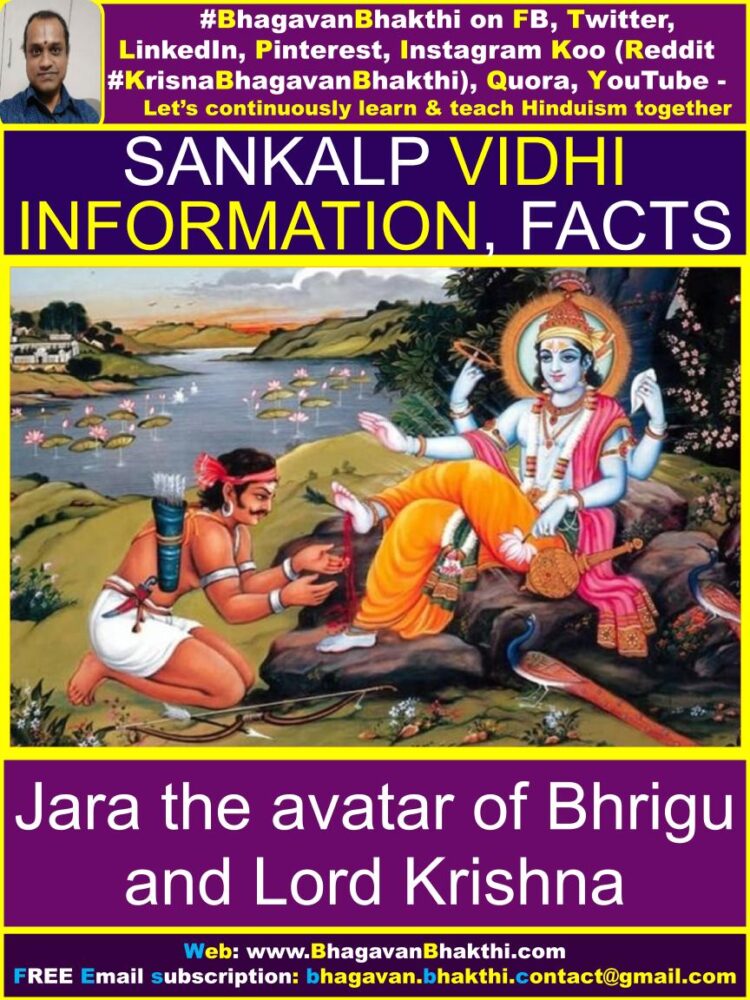
Bauddhavathare: In the time when Bhagavan Sri Vishnu took the birth as Buddha.
Shalivahana Sakhe: Moving forward, based on the concept of Sakha, after passing through the Yudhishthira Sakha and Vikrama Sakha, we are presently in the Shalivahana Saka. (1936 years since its beginning in 78 AD).
(As per Arabs, Shalivahana is the same person called ‘Suleiman’ and as per the Christians, ‘Solomon’ is same person. Here only difference is in the pronunciation. Shalivahana = Suleiman = Solomon.)
Now let us under about the ‘Geographical placings’ as per our Vedic Dharma:
Jambudveepe: Out of seven Dveepas (islands), we are in the Jambudveepa (an island called jambudveepa) on the Earth (Bhumandala) surrounded by the Ocean of salt (in Sanskrit it is called as ‘Lavana Samudra’ – Salted Ocean).
To know more information about the 7 islands as per the Hindu Sanatana Dharma, you can visit this link: Real Bharata of India & Hinduism 7 islands

Meror Dakshina Bhaage (paarsve): To the south of Meru Parvata (a mountain named Meru) is in the center of Jambu Dveepa (Jambu island).
Bhaaratavarshe: There are nine Varshas in this Universe. In this we are in Bhaaratha Varsha (read as Bhaarata varsha and not Bharata varsha) which is in the southern region of Meru Parvata. (As per our elders, the Meru Parvata is at the Himalayas and the place (varsha) south of this Meru Parvata is Bhaarata Varsha.)
Bharatakhande: In the land ruled by King Bharata, which is in the continent called Bharata Khande (present Asia).
Godaavari Dakshina Teere: A place near the south of the holy river Godavari (Since I stay at this place, I have given like this. Thus depending on location this will change.)

Mama Svagruhe (my own house) or Shobhana Gruhe (or a rented house): This may change depending on the place where one is performing the Sankalpa Karma.
Devata Sannidhau: In the presence of the Bhagavan / God dwelling in my house (This also differs depends on the place where one is performing the Sankalpa Karma.)
Current Day timeframe (Description of the day)
Asmin Vartamaanena: Asmin = At the, Vartamaanena = Present timeframe
Vyavahaarike – Chaandramaanena: As per present Chandramana (Lunar) calendar that is in vogue.
Samvatsare: There are sixty years as per Chandramana (Lunar) Calendar which gets repeated cyclically starting from Prabhava and ending with Akshaya.
To know the list of Samvatsaras, you can visit this link: Yugadi / Hindu new year, April Fools day and Roman new year relationship
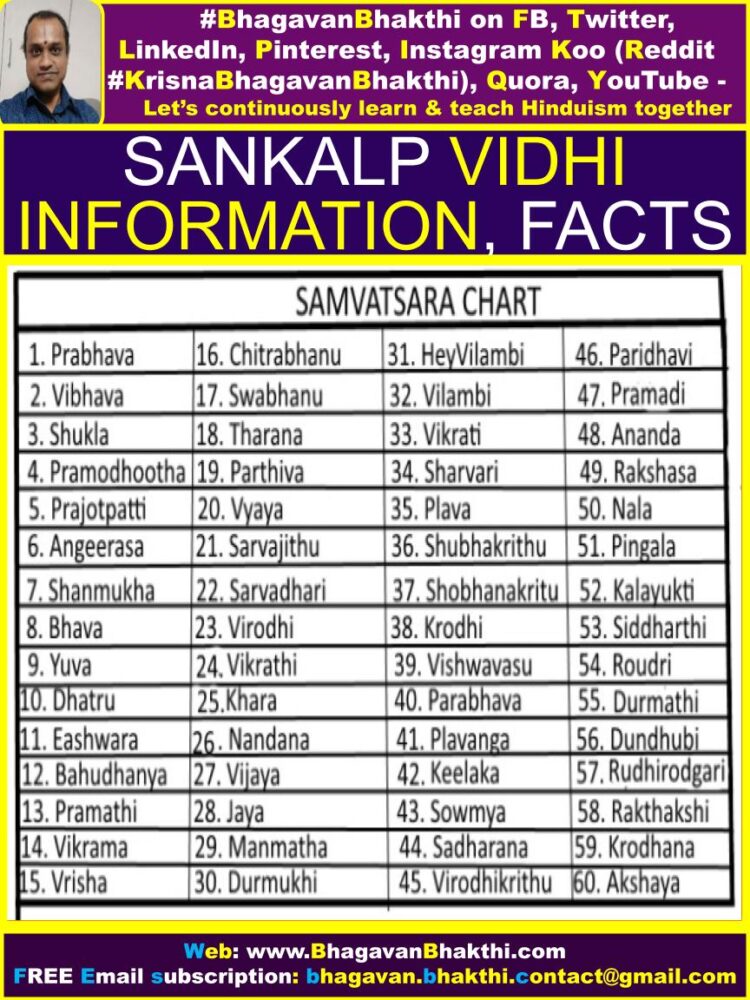
Aayane: As per the Hindu Shastras, an year is divided into two parts based on the movement of Sun into Makara raashi called Uttarayana and Karkataka raashi called Dakshinayana.
Rutau: One year is again divided into six rutus / seasons starting from Vasanta, Grishma, Varsha, Sharad, Hemanta and Sisira.
Maase: Every season or rutu comprises of two months and each rutu is named after the star present on the full Moon day of the month as per Chandramana (Lunar) Calendar starting from Chaitra and ending with Phalguna.
According to Suryamana (solar) calendar it is referred as per the movement of Sun into each Zodiac (Raasi) starting from Mesha (Aries) and ending with Meena (Pisces).
Pakshe: Each month (Maasa) is again divided into two Pakshas / fortnights; based on the Moon’s position (waxing Moon or waning Moon) called Shukla Paksha (starting from Prathama / Padya to Purnima) and Krishna Paksha (starting from Prathama / Padya to Amavasya).
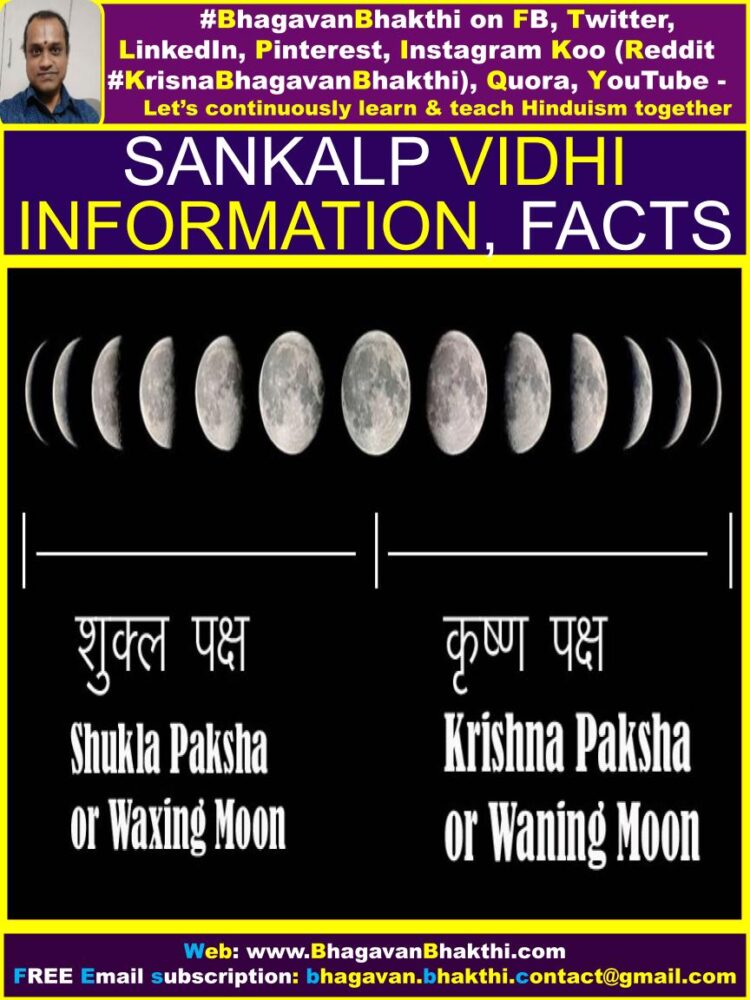
Tithau: Every paksha comprises of 15 tithis (days) out of which, 14 gets repeated in both pakshas and the 15th one will be either Purnima or Amavasya.
Vaasare: We all know that there are seven days in a week starting from Sunday (Bhanuvara) which gets repeated cyclically and ends on Saturday (Shanivara).
Nakshatre (Constellation): There are twenty seven (27) stars as per the Panchanga / Almanac. These are placed in 12 rashis of the zodiac. These stars cyclically get repeated starting from Ashwini and ending with Revati.
Yoge: In Hindu Shastras, there are 27 yogas in the Panchanga / Almanac starting from Vishkumbha and ending with Vaidruti. These Yogas also get repeated cyclically.
Karane: Similarly in the Hindu Shastras, there are eleven (11) Karanas out of which seven gets repeated and four occurs on specific days, that is, Shukla Prathama (Padya), (Kimsthugna), Bahula Chaturdasi (Sakuni), and Amavasya (Chatushpaath, Naagava).
In practice the names of Yoga and Karana are not spelled out. Instead it is just mentioned as Subha Yoge, Subha Karane. On some occasions it is mentioned as Vishnu Yoge and Vishnu Karane.
Evam guna visheshana vishitayaam – Subha tithau…

Gotra (Lineage) : Description of Gotra (Rishi lineage) in which one is born which is generally known from forefathers (E.g., Saptarishis).
(Nowadays many have misconception that marrying in the same Gotra is acceptable. But this is completely against the Shastras. Gotra means the lineage of our forefathers.)
(Our DNA and hormones etc will remain same with the same Gotra people. Thus if marriage takes place within the same Gotra, then there is a great chance of the children born will be handicapped both mentally and physically.)
(Overall, with same Gotra, it is like brother and sister getting marrying to each other. Thus marriage in the same Gotra should be 100% avoided.)
Here one’s Gotra Pravara to be spelled out.

Namadheyasya: Name of the person who is doing the Sankalpa.
Purpose of the Sankalpa: Each have their own purpose(s) and thus purpose will differ according to the desire, need, cause etc as per the individual.
It could be for one’s own materialistic benefits or for family reasons or for self Gyana Bhakti Vairaagya prapthyartham (to obtain the knowledge, to increase devotion, asceticism) or for performing sacred rites or for the sake of society, forefathers etc.
How Sankalpa should be performed : Either self or with the help of a learned Purohit (priest) it can be done. If it is self, “Bhagavat preranaya prapta vidya anusaarena yatha Shakti”: (As per the motivation of God to gain the knowledge and as per our capability.)
If it is through a Purohit (priest), “Aachaarya Mukhena”: (As per the instructions given by Aachaarya or Purohit or Priest.)
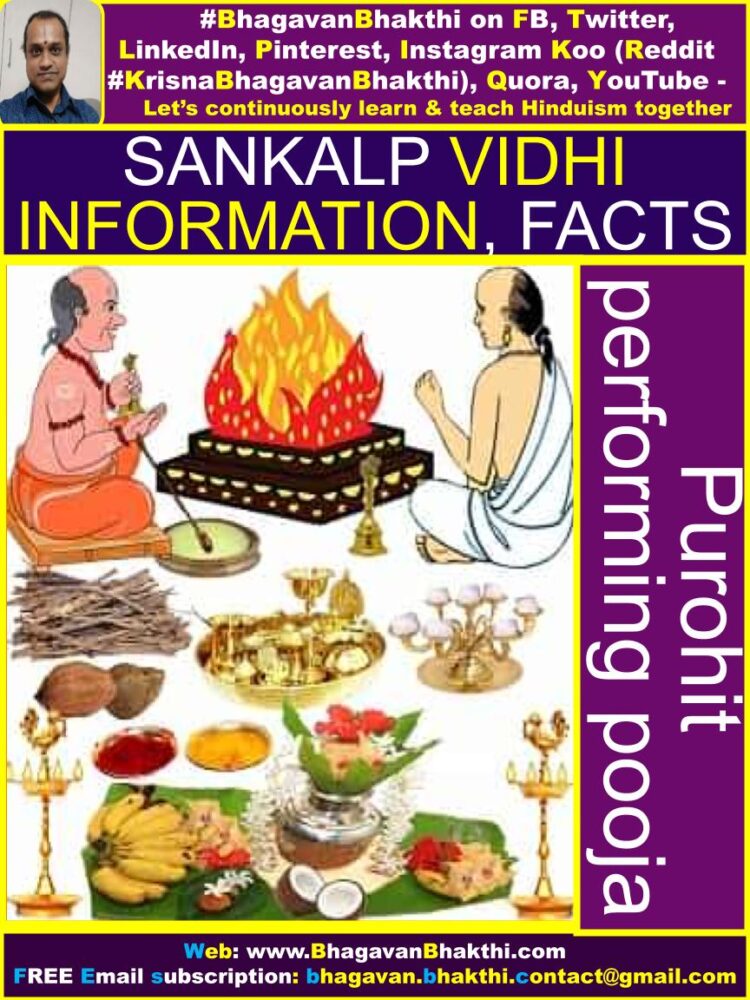
Reference to the specific Deity: We should address to whom (which Devata) we are doing the Sankalpa.
Reference to the name, nature and mode of ritual (Karma): The ritual could be Nitya or Naimittika Karma or any specific ritual, pooja, vrata, homa, seva, for Pitru Kaarya, Daana etc.
Typical Sankalpa examples: With reference to the current day. The above Vedic Sankalpa (mantra is as given above) has very deep meaning and significance behind its words. During the Sankalpa, we indeed meditate on the Supreme form that has come into existence trillions of years ago.
No work can be 100% accomplished without dedication and off course without blessings of Bhagavan Sri Vishnu nothing can be gained. For successful completion of any aaradhana, Bhagavan Sri Vishnu’s blessings is a must which can be obtained with sincere devotion and complete surrender to him.
Without Sankalpa, no objective can be accomplished. No remedies, pooja or karma yields results without Sankalpa. One must always start a work with a proper Sankalpa, with proper understanding of its meaning and significance.

The idea behind praying for the Sankalpa is to eradicate the feeling of doer-ship or ahankaara. Therefore, before making a Sankalpa one should always bear in mind that, Sankalpa will not result into harming of anyone’s feelings or intentionally done to hurt anybody.
Sankalpa is a deep routed desire that gets registered with the soul. If Sankalpa cannot be completed in one life time, the desire will not get vanished after the end of life. The desire will remain as a ‘poorva janma vaasana’ (earlier lives Karmas) that gets manifested at some point of time in future births.
The aatma / soul takes many births to accomplish the unfinished task and it continues to take births till it finally gets detached from the desire. Since time immemorial, Sankalpa being uttered by everyone in Hindu religion has percolated down from ancestors and taught by forefathers in every family.
It is the specialty of Hindu culture that a tradition started by our ancestors since unknown time and is still alive. The greatest significance of the ritual Sankalpa lies in its effort to preserve the Hindu tradition.
It is we who should preserve our own Hindu tradition. In today’s life people are just going behind money and intimacy. But this won’t help us when we become old. Only real Sankalpa towards Bhagavan Lord Sri Vishnu will help us in the upliftment in our lives and Karmas.
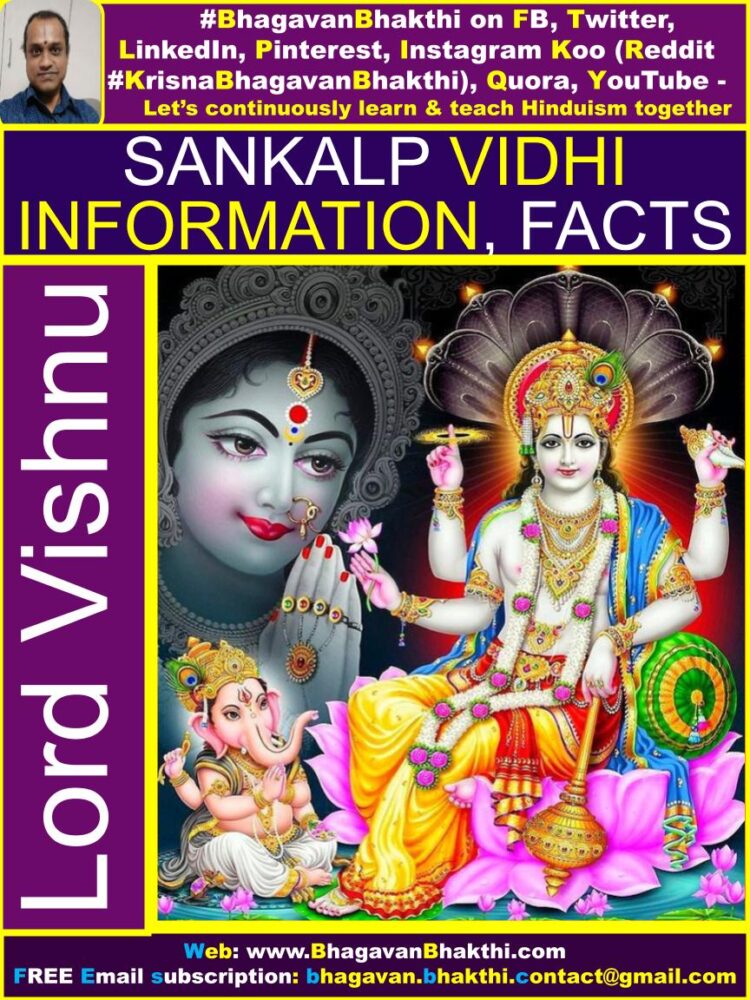
You may be aware that, many people will have lots of money. But that person won’t be able to eat food at some point of time in his / her old age.
He / She even can’t touch food even though he / she desires to eat food. Because, that particular person would had already completed his / her quota of food on this earth by wasting lots of food in his / her earlier lifespan.
Just making money is completely waste of time. Instead we should give importance about Bhagavan Sri Vishnu. Kali Yuga is the best time to learn about Bhagavan Sri Vishnu and other Devatas.
This is because, doing one day bhakti towards Bhagavan Sri Vishnu in Kali Yuga is equal to doing 1000 days of bhakti in Satya Yuga. This may look illogical to many.
But for a real bhakta / devotee, that is completely logical and he / she will definitely perform all the rituals as per his / her capabilities and will definitely attain the higher planets and ultimately the Lord Sri Vishnu’s abode ‘Vaikuntha’.
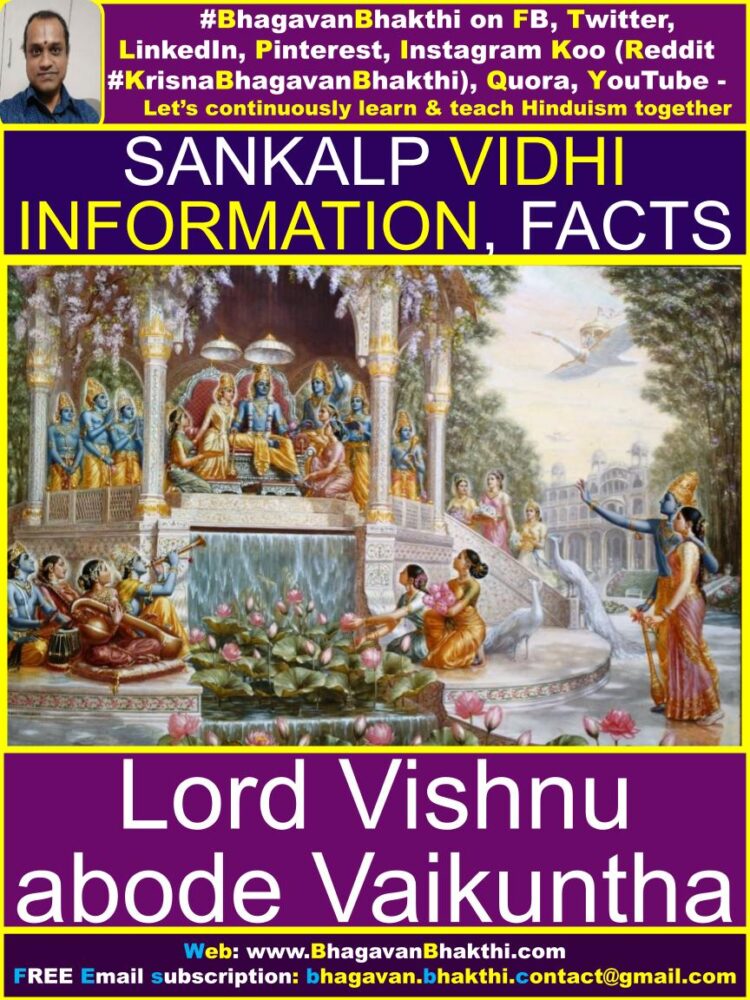
Continue reading about Hinduism from here : Hinduism information, facts, importance, significance etc.
More information will be added to this on regular basis. Please visit this post after some time to get updated information.
To watch videos on #Hinduism #Sanskrit language, SUBSCRIBE to my YouTube channel from this below link:
#BhagavanBhakthi YouTube channel
To know about “List of Naraka (hell) names with meaning (Hinduism)“, please click the below link:
List of Naraka (hell) names with meaning (Hinduism)
To know about “How to avoid going to Hell (Naraka)“, please click the below link:
How to avoid going to Hell (Naraka)
To know about “After punishment in hell (Naraka) why suffering on earth“, please click the below link:
After punishment in hell (Naraka) why suffering on earth
To know more about “Lord SriGaruda Deva (Raja) and Garuda Panchami“, you can visit the below link:
Garuda Panchami significance – About Garuda Raja
To know about “list of Purana names with meaning“, you can visit the below link:
List of Purana names with meaning
Dear friends, if you need any clarifications about this post, kindly let me know, I will definitely try to answer all of them.
Also your one LIKE, one COMMENT, One Share, one SUBSCRIPTION is highly important.
This will help to know the quality of this content and also it will be helpful to know if any improvements is required for the content.
If you feel this content is useful to you and has helped you to improve your knowledge, kindly share this with your well-wishers.
Because “SHARING MEANS CARING”.
To receive FREE EMAIL SUBSCRIPTION about #BhagavanBhakthi, you can send an email to [email protected] from your email ID.
NAMASTE!
Sri Gurubhyo Namaha
Sri Krishnaayana Namaha
Sri Krishnaarpanamastu
Share in Social Media
Wonderful explanation of Sankalpa. Thank you for taking all the efforts. May more people read and benefit.
Namaste Karti CV,
Thanks for your beautiful words.
I would like to suggest you to read the below:
Yugadi / Hindu new year, April Fools day and Roman new year relationship
Keep in touch!
Shubhamastu!
Jai Hari! Please explain how to do proper samarpnam ( समर्पन). Thanks
To do samarpanam, you have to chant this shloka of Sri Vishnu Sahasranama:
कायेन वाचा मनसेन्द्रियैर्वा ।
बुद्ध्यात्मना वा प्रकृतिस्वभावात् ।
करोमि यद्यत्सकलं परस्मै ।
नारायणयेति समर्पयामि ।।
Then finally we should tell this:
|| सर्वं श्री कृष्णार्पणमस्तु ||
Shubhamastu!